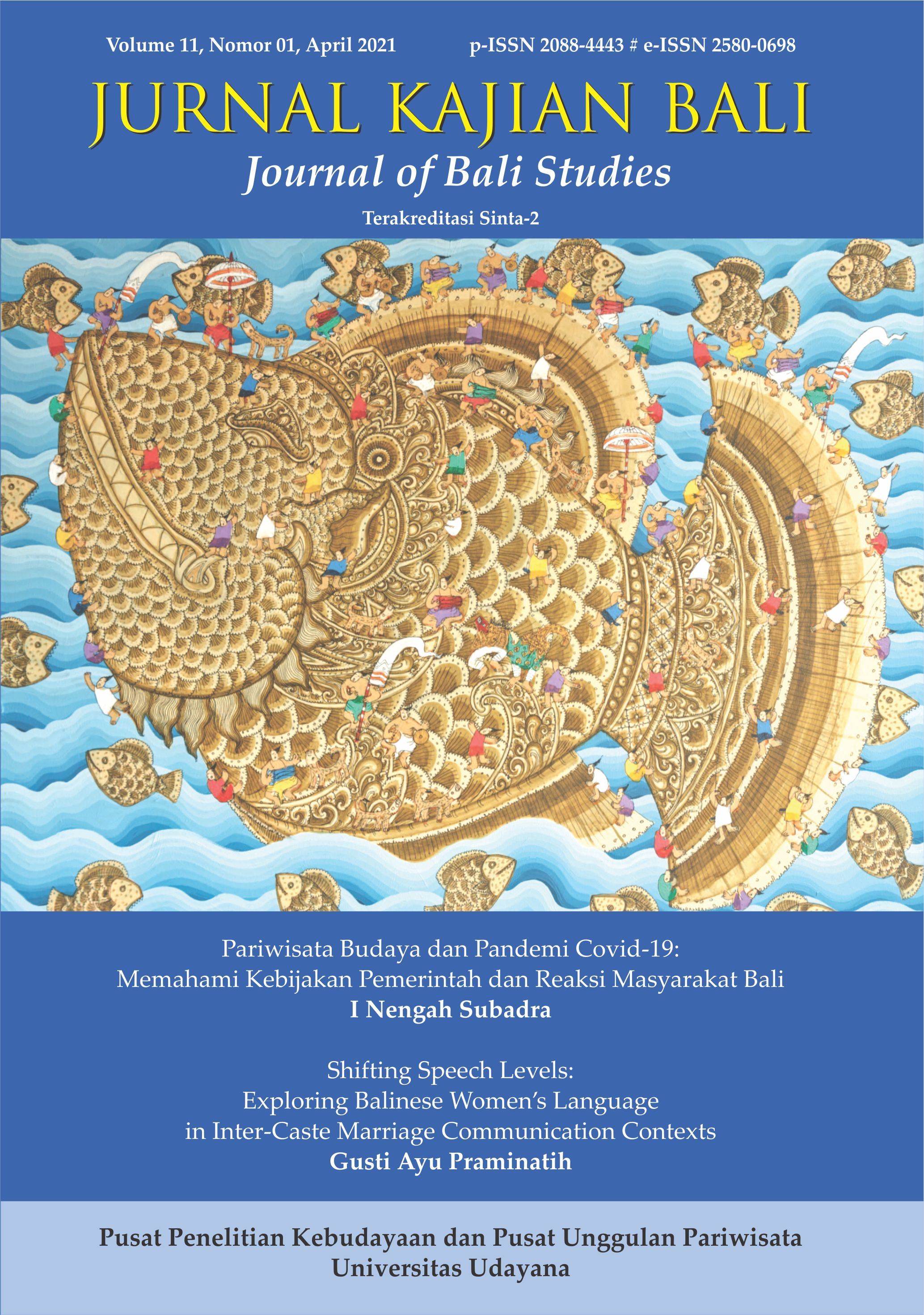Struktur dan Sifat Pelesapan dalam Cerita Rakyat Bali
Abstract
The focus of this article is about ellipsis that occurs in the discourse in the Balinese folklore. Ellipsis is a part of the cohesiveness of a discourse so that it becomes a complete discourse. The research method used is descriptive qualitative analysis. This study uses ellipsis theory from Halliday and Hasan which is supported by McCarthy's ellipsis deixis theory. The data source was taken from a collection of tales in the Balinese language, namely the book Pupulan Satua Bali II. The results of this study indicate that the ellipsis that occurs in the book of fairy tales is in the form of nominal ellipsis which refers to humans (people) in the conversation and story prologue, verbal ellipsis that occurs in fairy tale conversations, refers to lexical ellipsis in the verb word class, and the ellipsis of clauses because clauses are considered as expressions of speech functions, such as statements, questions, responses, and clauses that have a structural part consisting of core and propositional elements. Even though there is an ellipsis, the process of conveying the content and message of the story is still effective.
Downloads
References
Ahyani, Latifah Nur. (2010). “Metode Dongeng dalam Meningkatkan Perkembangan Kecerdasan Moral Anak Usia Prasekolah”, Jurnal Psikologi. 1(1), pp. 24-32
Aryani, M.R.D. (2019). “The Ellipsis of Grammatical Functions in Coordinative Structure of Japanese Language”, International Journal of Linguistics, Literature, and Culture, 6 (5), pp. 92-101.
Chen, W. (2016). “Ellipsis and Cognitive Semantics”, Theory and Practice in Language Teaching, 6 (11), pp. 2134-2139.
Dunung, W. (1998). “Pelesapan Subjek dalam Bahasa Bali” (Tesis). Denpasar: Program Magister (S2) Linguistik Universitas Udayana.
Fukushima, T. (2005). “Japanese Continuative Conjuction ga as a Semantic Boundary Marker”, Language and Communication, 25 (1), pp. 81-106
Hassan,H.F., Taqi, J.S.M. (2011). “Nominal Ellipsis in English & Arabic and Its Influence on the Translation of the Meanings of Some Selected Quranic Verses: A Contrastive Study”, Journal of College of Education for Women, 22 (3), pp. 637-658.
Haugh, M. (2008). “Utterance-Final Conjunctive Particles and Implicature in Japanese Conversation”, International Pragamatics, 18 (3), pp. 425-251.
Hendriks, P, & J. Spenader. (2005). “Why be Silent? Functions of Ellipsis”. In Proceeding of the ESSLLPI 2005 Workshop on Cross-Modular Approaches to Ellipsis. Paper to be presented August 8,2005, Herot_Watt University Edinburgh, Scotland.
Halliday, M.A.K & Hasan, R. (1976). Cohesion in English. London: Longman.
Intan, Tania. (2020). “Dongeng Barbe Bleue ‘Si Janggut Biru’ Karya Charles Perrault dalam Kajian Persepsi Pembaca Aktif”, Aksara, 32 (1 ). pp. 31-46.
Muliani, NK & Muniksu, IMS. (2020). “Peraturan Gubernur Bali No. 80 Tahun 2018 Tentang Perlindungan dan Penggunaan Bahasa, Aksara, dan Sastra bali serta Penyelenggaraan Bulan Bahasa Bali”, Kalangwan: Jurnal Pendidikan Agama, Bahasa, dan Sastra, 10 (1), pp. 36-40.
Nurgiantoro, B. (2018). Sastra Anak: Pengantar Pemahaman Dunia Anak. Yogyakarta: UGM Press.
Parwati, SAPE. (2018). Verba “Memasak” dalam Bahasa Bali: Kajian Metabahasa Semantik Alami (MSA)”, Aksara, 30 (1), pp. 121-132.
Purnama, IGG. (2016). “Kritik atas Perubahan dalam Cerpen Berbahasa Bali “Ngurug Pasih”, Jurnal Kajian Bali (Journal of BaliStudies), 6 (1), pp. 291-308.
Sari, Ida Ayu Laksmita. (2019). “Unsur-unsur Pengetahuan Sosial dalam Cerita Rakyat Bali Aga dan Buku Pelajaran Sekolah Dasar Zaman Kolonial Belanda”, Jurnal Kajian Bali (Journal of Bali Studies), 9 (2), pp. 499–520.
Sari, Ida Ayu Laksmita dan I Nyoman Darma Putra. (2020). “Narrative on Nature Conservation: A Comparative Study of the Folktales of Bali Aga and Ainu”, Journal KEMANUSIAAN, 27 (2), pp. 59-78.
Suhirman. (2017). “Cerita Tradisional Sasak Lombok Sebagai Sarana Transmisi Budaya Untuk Membentuk Karaktek Anak Sejak Usia Dini”, Jurnal Golden Age, 1 (1), pp. 48-55.
Tim Dewan Pendidikan Tabanan. (2016). Pupulan Satua Bali II Klinik Pendidikan Tabanan. Bali: Swadaya Tabanan.
Tinggen, I N. (2001). Satua-Satua Bali (XII). Bali: Bubunan.
Turaeni, NNT, Hardiningtyas, Puji, R. (2020). “Kritik Sosial Bermuatan Lokal Bali dalam Kumpulan Cerita Nguntul Tanah Nulengek Langit Karya I Made Suarsa”, Aksara, 32 (2) 223-234.
Tsutsui, Michio. (1984). “Particle Ellipsis in Japanese”. Ph.D dissertation, University of Illionois at Urbana-Champaign.
Zaim, M. (1993). “Pelesapan Nomina pada Konstruksi Koordinatif Bahasa Inggris”. (Tesis). Jakarta: Program Magister (S2) Linguistik Universitas Indonesia.

This work is licensed under a Creative Commons Attribution 4.0 International License.



















